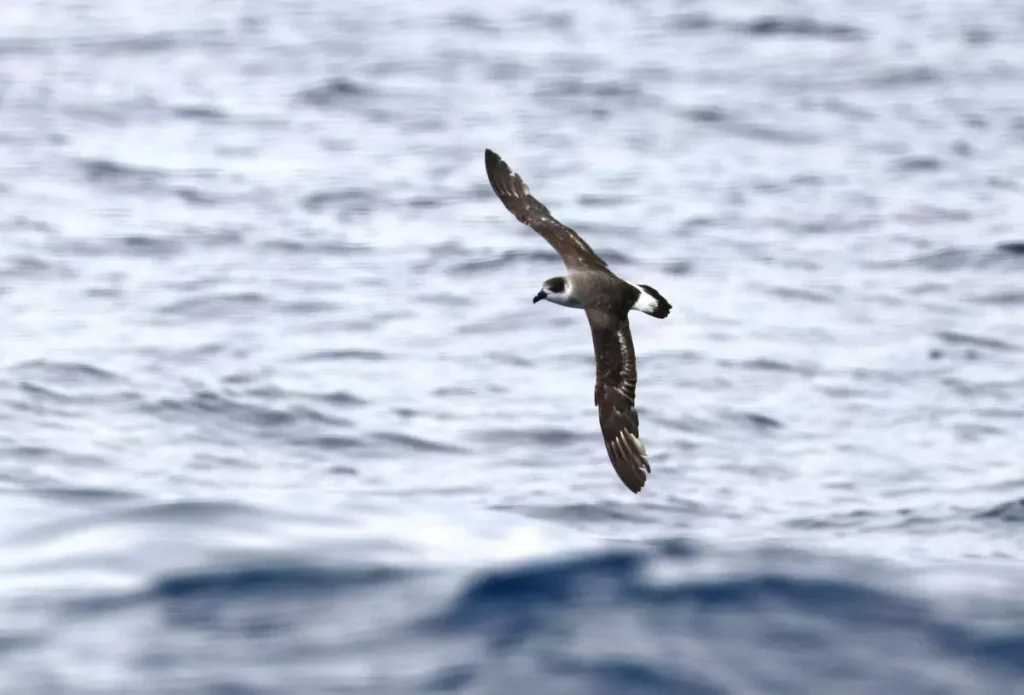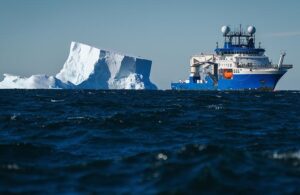- South Texas Students Meet Accordion Music Icons Los Tigres Del Norte In Edinburg Thanks To Khs America/Hohner Alianza Académica Initiative
- Fragile Planet Offers a Nighttime Wildlife Experience
- Falcons Soccer Off & Running
- Cameron County Receives Funds to Improve Two Parks
- Falcons Complete First Half of 32-6A
- School District to Help out Victims of California Wildfires
- Sand Castle Days Continued Despite Unexpected Weather
- Ready for District
- Discussion of Garbage Dumpster Rates, Agreements Between State & City on Highway Regulations, and More
- 31st Annual Shrimp Cook-Off is Right Around the Corner
Service Finalizes Listing of Black-Capped Petrel as an Endangered Species
- Updated: January 13, 2024
Previously proposed as threatened, endangered status is now warranted

Today, the U.S. Fish and Wildlife Service is finalizing the listing of the black-capped petrel as an endangered species under the Endangered Species Act (ESA).
Previously proposed as threatened in 2018, the Service reopened the comment period on its 2018 proposal to present significant new information relevant to consideration of the status of the species. This new information indicated threats to the species were more severe and imminent than described in the 2018 proposed rule. This new information has been incorporated in the updated Species Status Assessment (SSA) report included in the final rule.
“This listing represents an important step forward in protecting this remarkable seabird,” said Mike Oetker, acting Service Regional Director. “By working hand-in-hand with our conservation partners and affected communities, we can tap into the best available science and on-the-ground expertise to inform our decisions. Through collaboration and teamwork, we hope to reverse the declines in black-capped petrel populations and ensure the long-term survival of this species.”
Black-capped petrels are pelagic seabirds that only nest on the island of Hispaniola in the Caribbean. Known as one of the gadfly petrels because of their speedy, weaving flight, black-capped petrels are widely distributed and travel long distances to foraging areas in the western Atlantic and southern Caribbean basins and the central and northeastern Gulf of Mexico. Recent satellite tracking studies have also documented their use of near-shore areas off the northern coast of Central and South America.
Officially known as the black-capped petrel in current ornithological literature, it is also known by several distinct common names throughout its range, like “diablotin” (French and Spanish-speaking range states), “chathuant” (Haiti), and “bruja” or “chanwan” (Cuba).
The ESA requires the Service to list species as endangered or threatened regardless of which country the species lives in. Benefits to the species include prohibitions on certain activities including import, export, take, commercial activity, interstate commerce, and foreign commerce. By regulating activities, the United States ensures that people under the jurisdiction of the United States do not contribute to the further decline of listed species. Although the ESA’s prohibitions regarding listed species apply only to people subject to the jurisdiction of the United States, the ESA can generate conservation benefits such as increased awareness of listed species, research efforts to address conservation needs, or funding for conservation of the species in its range countries. The ESA also provides for limited financial assistance to develop and manage programs to conserve listed species in foreign countries, encourages conservation programs for such species, and allows for assistance for programs, such as personnel and training.
Major threats to the black-capped petrel include habitat loss and degradation due to deforestation and forest fires and depredation by nonnative mammals within its breeding grounds. Climate change will also continue to affect the species with increasing storm intensity and frequency, resulting in flooding of burrows and erosion of suitable nesting habitat.
Previously, the Service had determined that critical habitat for the species was not prudent. However, due to new information, the Service has determined there are factors affecting the marine habitat within U.S. jurisdiction, therefore, critical habitat is “prudent but not determinable” since we do not have enough information to complete that analysis. When critical habitat is not determinable, the ESA allows the Service an additional year to publish a critical habitat designation. We anticipate publishing proposed critical habitat for the black-capped petrel in 2024.
Today’s announcement comes as the ESA turns 50 years old in 2023. Throughout the year, the Department of the Interior will celebrate the ESA’s importance in preventing imperiled species’ extinction, promoting the recovery of wildlife and conserving the habitats upon which they depend. The ESA has been highly effective and credited with saving 99% of listed species from extinction.
This final rule will become effective on January 29, 2024.
Supporting materials used in preparing this rule, such as the species status assessment report, are available at https://www.regulations.gov, search for Docket No. FWS-R4-ES-2018-0043.
FOR FURTHER INFORMATION CONTACT: José A. Cruz-Burgos, Threatened and Endangered Species Program Coordinator, U.S. Fish and Wildlife Service, Caribbean Ecological Services Field Office, caribbean_es@fws.gov; telephone 786–244–0081. Individuals in the United States who are deaf, deafblind, hard of hearing, or have a speech disability may dial 711 (TTY, TDD, or TeleBraille) to access telecommunications relay services. Individuals outside the United States should use the relay services offered within their country to make international calls to the point-of-contact in the United States.
The mission of the U.S. Fish and Wildlife Service is working with others to conserve, protect, and enhance fish, wildlife, plants, and their habitats for the continuing benefit of the American people. For more information on our work and the people who make it happen, visit https://www.fws.gov/program/southeast-region. Connect with us on social media: Facebook, X (formerly known as Twitter), Flickr, and YouTube.

Hoy, el Servicio Federal de Pesca y Vida Silvestre (Servicio) está finalizando la inclusión del diablotín como especie en peligro de extinción bajo la Ley Federal de Especies en Peligro de Extinción (ESA, por sus siglas en inglés).
Anteriormente propuesto como especie amenazada, el Servicio reabrió el período de comentarios sobre su propuesta de 2018 para presentar nueva información significativa y relevante para la consideración del estatus de la especie. La nueva información indicó que las amenazas al diablotín eran más graves e inminentes que las descritas en la regulación propuesta en 2018. Esta nueva información se ha incorporado en el informe actualizado de Evaluación de Estatus de la Especie (SSA, por sus siglas en inglés) incluido en la regulación final.
“Esta acción representa un importante paso adelante en la protección de esta extraordinaria ave marina”, dijo Mike Oetker, director regional interino del Servicio. “Al trabajar mano a mano con nuestros colaboradores conservacionistas y las comunidades afectadas, podemos aprovechar la mejor ciencia disponible y la mejor experiencia de campo para informar nuestras decisiones. A través de la colaboración y el trabajo en equipo, esperamos revertir la disminución de la población del diablotín y garantizar la supervivencia a largo plazo de esta especie”.
Los diablotines son aves marinas pelágicas que sólo anidan en la Isla de La Española en el Caribe. Son conocidos como uno de los petreles tábanos debido a su vuelo veloz y entrecruzado, están ampliamente distribuidos y viajan largas distancias a las áreas de alimentación en las cuencas del Atlántico occidental, el sur del Caribe y el centro y noreste del Golfo de México. Estudios recientes de rastreo satelital también han documentado la especie en el litoral frente a la costa norte de América Central y América del Sur.
Oficialmente es conocido como petrel antillano en la literatura ornitológica actual, pero también es conocido por varios nombres comunes a lo largo de su área de distribución: “diablotín” (en los países del área de distribución de habla francesa y española), “chathuant” (Haití) y “bruja” o “chanwan” (Cuba).
El ESA requiere que el Servicio liste especies en peligro o amenazadas, independientemente del país en el que viva la especie. Los beneficios para la especie incluyen prohibiciones de ciertas actividades, incluyendo la importación, exportación, captura, actividad comercial, comercio interestatal y comercio extranjero. Al regular las actividades, los Estados Unidos garantiza que las personas dentro de su jurisdicción no contribuyan a una mayor disminución de las especies listadas federalmente. Aunque las prohibiciones del ESA con respecto a las especies listadas federalmente se aplican sólo a las personas sujetas a la jurisdicción de los Estados Unidos, el ESA puede generar beneficios de conservación como una mayor conciencia sobre las especies incluidas en la lista, esfuerzos de investigación para abordar las necesidades de conservación o financiación para la conservación de las especies en su territorio o países dentro del área de distribución de la especie. El ESA también proporciona asistencia financiera limitada para desarrollar y gestionar programas para conservar especies listadas en países extranjeros, fomenta programas de conservación para dichas especies y permite asistencia para programas, como personal y capacitación.
Las principales amenazas para el diablotín incluyen la pérdida y degradación de su hábitat debido a la deforestación y los incendios forestales y la depredación por parte de mamíferos no nativos dentro de sus zonas de reproducción. El cambio climático también seguirá afectando a la especie con tormentas de mayor intensidad y frecuencia, lo que provocará inundaciones de madrigueras y erosión del hábitat adecuado para anidar.
Anteriormente, el Servicio había determinado que el hábitat crítico para la especie no era prudente. Sin embargo, debido a nueva información, el Servicio ha determinado que existen factores que afectan el hábitat marino dentro de la jurisdicción de los Estados Unidos, por lo tanto, el hábitat crítico es “prudente pero no determinable” ya que no tenemos suficiente información para completar este análisis. Cuando el hábitat crítico no es determinable, el ESA concede al Servicio un año adicional para publicar una designación de hábitat crítico. Anticipamos publicar una propuesta de hábitat crítico para el diablotín en 2024.
El anuncio de hoy se produce cuando el ESA cumple 50 años en 2023. A lo largo del año, el Departamento del Interior celebrará la importancia del ESA para prevenir la extinción de especies en peligro, promover la recuperación de la vida silvestre y conservar los hábitats de los que éstas dependen. El ESA ha sido muy eficaz y se le atribuye haber salvado de la extinción al 99% de las especies incluidas en la lista.
Esta regulación final entrará en vigor el 29 de enero de 2024.
Los materiales de apoyo utilizados en la preparación de esta regulación, así como el informe del SSA, están disponibles en https://www.regulations.gov, busque el Expediente No. FWS-R4-ES-2018-0043.
PARA MÁS INFORMACIÓN CONTACTE: José A. Cruz-Burgos, Coordinador del Programa de Especies en Peligro de Extinción, Servicio Federal de Pesca y Vida Silvestre, Oficina de Campo de Servicios Ecológicos del Caribe, caribbean_es@fws.gov; teléfono 786-244-0081. Las personas en los Estados Unidos que son sordas, sordociegas, con problemas de audición o con problemas del habla, pueden marcar el 711 (TTY, TDD o TeleBraille) para acceder a los servicios de retransmisión de telecomunicaciones. Las personas fuera de los Estados Unidos deben utilizar los servicios de retransmisión que se ofrecen dentro de su país para realizar llamadas internacionales al punto de contacto en los Estados Unidos.
La misión del Servicio Federal de Pesca y Vida Silvestre es trabajar con otros para conservar, proteger y mejorar los peces, la vida silvestre, las plantas y sus hábitats para el beneficio continuo del pueblo americano. Para obtener más información sobre nuestro trabajo y las personas que lo hacen posible, visite https://www.fws.gov/program/southeast-region. Conéctese con nuestra página de Facebook, X (anteriormente conocido como Twitter), Flickr, and YouTube.



